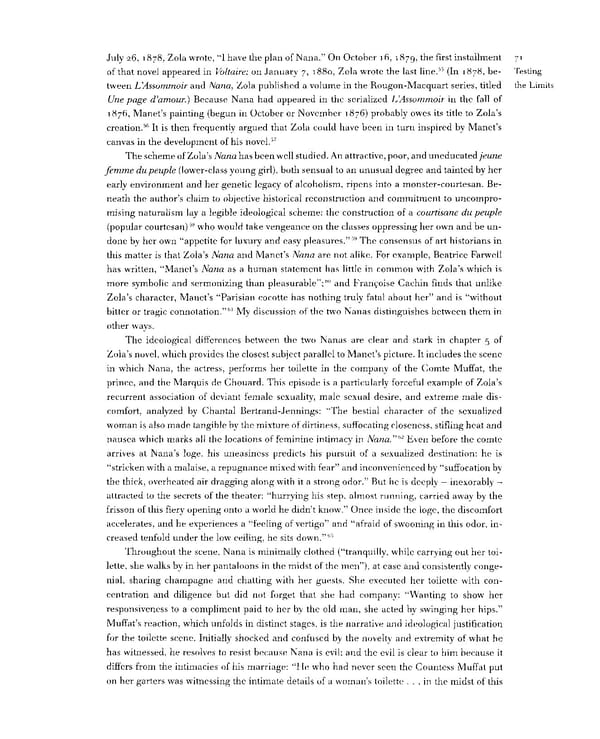me rst July 26, 1878, Zola wrote, "I have the plan of Nana." On October 16, 1879, fi installment ?i of that novel appeared in Voltaire; on January 7, 1880, Zola wrote the last line.55 (In 1878, be- Testing tween L'Assommoir and Nana, Zola published a volume in the Rougon-Macquart series, titled the Limits Une page d'amour.} Because Nana had appeared in the serialized L'Assommoir in the fall of 1876, Manet's painting (begun in October or November 1876) probably owes its title to Zola's 56 creation. It is then frequently argued that Zola could have been in turn inspired by Manet's canvas in the development of his novel.57 The scheme of Zola's Nana has been well studied. An attractive, poor, and uneducated jeune femme dupeuple (lower-class young girl), both sensual to an unusual degree and tainted by her early environment and her genetic legacy of alcoholism, ripens into a monster-courtesan. Be- neath the author's claim to objective historical reconstruction and commitment to uncompro- mising naturalism lay a legible ideological scheme: the construction of a courtisane du peuple 58 (popular courtesan) who would take vengeance on the classes oppressing her own and be un- done by her own "appetite for luxury and easy pleasures."59 The consensus of art historians in this matter is that Zola's Nana and Manet's Nana are not alike. For example, Beatrice Farwell has written, "Manet's Nana as a human statement has little in common with Zola's which is 60 more symbolic and sermonizing than pleasurable"; and Franchise Cachin finds that unlike Zola's character, Manet's "Parisian cocotte has nothing truly fatal about her" and is "without 61 bitter or tragic connotation." My discussion of the two Nanas distinguishes between them in other ways. The ideological differences between the two Nanas are clear and stark in chapter 5 of Zola's novel, which provides the closest subject parallel to Manet's picture. It includes the scene in which Nana, the actress, performs her toilette in the company of the Comte Muffat, the prince, and the Marquis de Chouard. This episode is a particularly forceful example of Zola's recurrent association of deviant female sexuality, male sexual desire, and extreme male dis- comfort, analyzed by Chantal Bertrand-Jennings: "The bestial character of the sexualized woman is also made tangible by the mixture of dirtiness, suffocating closeness, stifling heat and 62 nausea which marks all the locations of feminine intimacy in Nana." Even before the comte arrives at Nana's loge, his uneasiness predicts his pursuit of a sexualized destination: he is "stricken with a malaise, a repugnance mixed with fear" and inconvenienced by "suffocation by the thick, overheated air dragging along with it a strong odor." But he is deeply — inexorably — attracted to the secrets of the theater: "hurrying his step, almost running, carried away by the frisson of this fiery opening onto a world he didn't know." Once inside the loge, the discomfort accelerates, and he experiences a "feeling of vertigo" and "afraid of swooning in this odor, in- 63 creased tenfold under the low ceiling, he sits down." Throughout the scene, Nana is minimally clothed ("tranquilly, while carrying out her toi- lette, she walks by in her pantaloons in the midst of the men"), at ease and consistently conge- nial, sharing champagne and chatting with her guests. She executed her toilette with con- centration and diligence but did not forget that she had company: "Wanting to show her responsiveness to a compliment paid to her by the old man, she acted by swinging her hips." Muffat's reaction, which unfolds in distinct stages, is the narrative and ideological justification for the toilette scene. Initially shocked and confused by the novelty and extremity of what he has witnessed, he resolves to resist because Nana is evil; and the evil is clear to him because it differs from the intimacies of his marriage: "He who had never seen the Countess Muffat put on her garters was witnessing the intimate details of a woman's toilette ... in the midst of this
 Prostitution & Impressionists Page 91 Page 93
Prostitution & Impressionists Page 91 Page 93